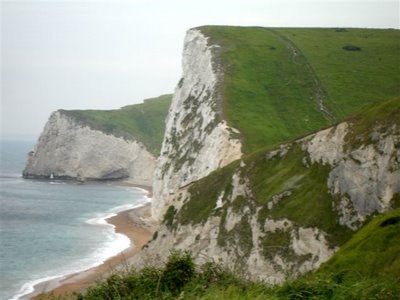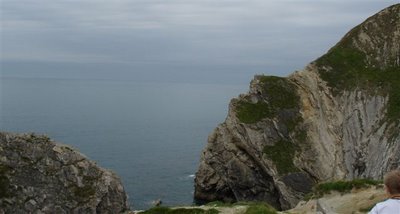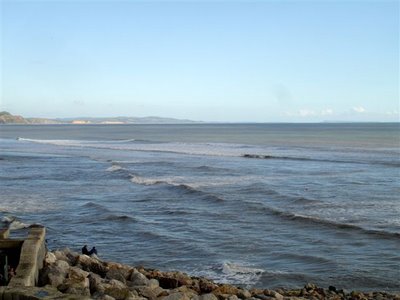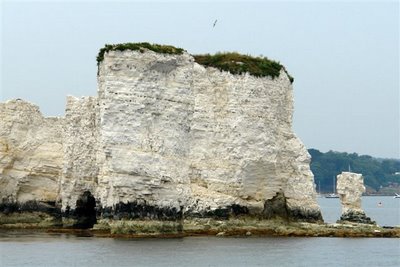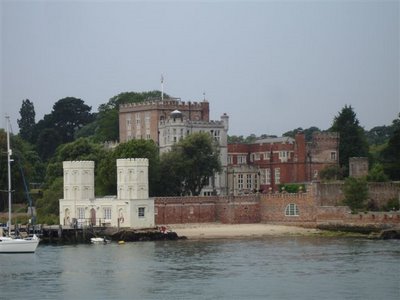The Rocks beneath my Feet - Part 1The Jurassic Coast is a living record of the last 250 million years, which encompasses the Mesozoic Era. The Mesozoic Era includes the Triassic, Jurassic and Creatious periods
The triassic Period of around 200 - 250 million years agoIn Triassic times, the Jurassic Coast was part of a super-continent called Pangaea. This landmass divided to form the continents of the modern world. The Jurassic Coast lay within the arid centre of the super-continent and hot desert conditions prevailed. A huge mountain chain lay to the west. The mountains gradually eroded and thier roots remain in Dartmoor, England and Brittany, France. Rivers flowed north and east, depositing pebbles and sand across southern England. The rivers spilled into the desert, creating vast lakes that were subject to evaporation
The Triassic rocks on the Jurassic Coast are red because deserts contain very little organic material, and, in its absence, iron forms red oxides. In the modern world the Namib Desert in Africa has the sort of conditions that the eastern part of the jurassic Coast would have known during the Triassic period
The Triasic period was a critical period of evolution. The Earth had been decimated by a large mass extinction event at the end of the previous period. The surviving groups of animals evolved and diversified. The first donosaurs evolved and went on to dominate life through the entire Mesozoic era
Most of the groups of four legged animals that we see today had arrived by the end of the Triassic period, including frogs, turtles, crocodiles and mammals
The Jurassic period of around 140 - 200 million years agoPangaea started to break apart during the Jurassic era. The Atlantic Ocean opened to the West of Britain and the Americas drifted away from Europe.
The Earth was relatively warm with high sea levels and hardly any polar ice caps. The rocks of the Jurassic Coast recorded the marine conditions during the Jurassic period, conditions that fluctuated from relatively deep seas to coastal swamps
Sea levels rose and fell in a series of cycles, depositing deep water clays, sandstones and finally shallow water limestones. The sea was shallower in the Middle Jurassic, creating an environment of islands surrounded by shallow shoals, similar to the Caribbean of today. Sea levels then deepened and finally shallowed towards the end of the Jurassic, creating the conditions for a forest to flourish in a tropical swamp environment
The expansion of shallow seas encouraged an explosion of life in the Jurassic period, with many species evolving rapidly in order to take advantage of the new habitats. Dinosaurs walked the earth and the dominant carnivores in the seas included plesiosaurs and crocodiles. This information is drawn from the evidence of fossils found on the Jurassic Coast, along with the numerous fossilised ammonites (related to the modern-day squid) that lived during this period
The Cretatious period of around 65 - 140 million years agoDuring the Cretatious period, America continied to drift away from Europe and the Atlantic developed into a recogniseable ocean. In the early part of the Cretatious era the Jurassic Coast would have been similar to the modern day Gulf of Arabia with lagoons covered by salt flats. Conditions would have become more hospitable, with lush swamps inhabited by dinosaurs. Mid-way through the period, movement of the earth deep under the South-West of England tilted the rocks to the East. As the Atlantic Ocean and Mediterranean expanded, a vast sea developed over the area. Within the clear warm waters billions of microscopic algae bloomed, their skeletons sank to the sea floor to form the pure white chalk that is seen in this area
The cretatious period was when some of the largest and most feared dinosaurs walked the earth. It is also the time when the first flowering plants are thought to have appeared. The end of this period in time is critical to the shape that the modern world would take. A mass extinction took place which heralded the end of the reign of the reptiles as the dominant life on earth. Dinosaurs, marine reptiles and ammonites were among those species that became extinct at this time. The modern world that followed would be dominated by mammals, flowering plants and grasses
Chalk: the youngest of the Cretatious rocks found across the Jurassic Coast
Source: The Official Guide to the Jurassic Coast


.JPG)




